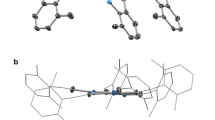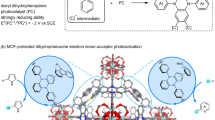Abstract
Sandwich structures formed by metal atoms intercalated between sp2-carbon planes can be found either in metal–graphite-based materials or discrete multinuclear sandwich complexes. Their reactivity, and in particular their dynamic behaviour, has recently attracted interest both from a structural and a practical aspect, for example in catalysis. However, progress in this area has been rather slow, and it remains difficult to elucidate their structure and behaviour at the molecular level. Here, we report two sandwich complexes—in which four palladium centres are incorporated between two π-conjugated ligands—which exhibit two modes of redox-switchable structural changes. In the first complex, the tetrapalladium chain is split by oxidation into two well-separated dipalladium units. This motion is reversed on reduction. In the second complex, reversible carbon–carbon coupling occurs between the ligands during the redox process.
This is a preview of subscription content, access via your institution
Access options
Subscribe to this journal
Receive 12 print issues and online access
$259.00 per year
only $21.58 per issue
Buy this article
- Purchase on Springer Link
- Instant access to full article PDF
Prices may be subject to local taxes which are calculated during checkout





Similar content being viewed by others
Change history
21 November 2011
In the version of this Article originally published online, an extraneous Pd atom appeared in Fig. 3. This has now been corrected in all versions of the Article.
References
Enoki, T., Suzuki, M. & Endo, M. Graphite Intercalation Compounds and Applications (Oxford Univ. Press, 2003).
Murahashi, T., Mochizuki, E., Kai, Y. & Kurosawa, H. Organometallic sandwich chains made of conjugated polyenes and metal–metal chains. J. Am. Chem. Soc. 121, 10660–10661 (1999).
Murahashi, T., Uemura, T. & Kurosawa, H. Perylene–tetrapalladium sandwich complexes. J. Am. Chem. Soc. 125, 8436–8437 (2003).
Tatsumi, Y., Nagai, T., Nakashima, H., Murahashi, T. & Kurosawa, H. Stepwise growth of polypalladium chains in 1,4-diphenyl-1,3-butadiene sandwich complexes. Chem. Commun. 1430–1431 (2004).
Tatsumi, Y., Shirato, K., Murahashi, T., Ogoshi, S. & Kurosawa, H. Sandwich complexes containing bent palladium chains. Angew. Chem. Int. Ed. 45, 5799–5803 (2006).
Tatsumi, Y., Murahashi, T., Okada, M., Ogoshi, S. & Kurosawa, H. A stable zerovalent palladium chain enveloped by a π-electron sheath of conjugated polyene ligands. Chem. Commun. 477–479 (2008).
Murahashi, T. et al. Discrete sandwich compounds of monolayer palladium sheets. Science 313, 1104–1107 (2006).
Murahashi, T., Kato, N., Uemura, T. & Kurosawa, H. Rearrangement of a Pd4 Skeleton from a 1D chain to a 2D sheet on the face of a perylene or fluoranthene ligand caused by exchange of the binder molecule. Angew. Chem. Int. Ed. 46, 3509–3512 (2007).
Murahashi, T., Inoue, R., Usui, K. & Ogoshi, S. Square tetrapalladium sheet sandwich complexes: cyclononatetraenyl as a versatile face-capping ligand. J. Am. Chem. Soc. 131, 9888–9889 (2009).
Murahashi, T., Usui, K., Inoue, R., Ogoshi, S. & Kurosawa, H. Metallocenoids of platinum: syntheses and structures of triangular triplatinum sandwich complexes of cycloheptatrienyl. Chem. Sci. 2, 117–122 (2011).
Crabtree, R. H. The Organometallic Chemistry of the Transition Metals (John Wiley & Sons, 2009).
Elschenbroich, C. Organometallics (Wiley-VCH, 2006).
Deubzer, B., Fritz, H. P., Kreiter, C. G. & Ofele, K. Spektroskopische Untersuchungen an metallorganischen Verbindungen XLV, 1H-NMR-Spektren von naphthalin-chrom(0)-tricarbonyl und seinen Derivaten. J. Organomet. Chem. 7, 289–299 (1967).
Whitlock, H. W., Reich, C. & Woessner, W. D. Synthesis and interconversion of some shift isomeric polyene–tetrahaptoiron tricarbonyl complexes. J. Am. Chem. Soc. 93, 2483–2492 (1971).
Albright, T. A., Hofmann, P., Hoffmann, R., Lillya, C. P. & Dobosh, P. A. Haptotropic rearrangements of polyene–MLn complexes. 2. Bicyclic polyene–MCp, –M(CO)3 systems. J. Am. Chem. Soc. 105, 3396–2411 (1983).
Dötz, K. H. & Jahr, H. C. Tunable haptotropic metal migration in fused arenes: towards organometallic switches. Chem. Rec. 4, 61–71 (2004).
Niibayashi, S., Matsubara, K., Haga, M. & Nagashima, H. Thermally reversible photochemical haptotropic rearrangement of diiron carbonyl complexes bearing a bridging acenaphthylene or aceanthrylene ligand. Organometallics 23, 635–646 (2004).
Shaw-Taberlet, J. A., Sinbandhit, S., Soisnel, T., Hamon, J-R. & Lapinte, C. Stereoelectronic effects of the arenophile (η5-Cp*)Ru+ in electron-rich σ-arylacetylide iron complexes including redox-driven haptotropic rearrangement: an approach toward readable binary molecular memory components. Organometallics 25, 5311–5325 (2006).
Barlow, S. & O'Hare, D. Metal–metal interactions in linked metallocenes. Chem. Rev. 97, 637–669 (1997).
Le Vanda, C. et al. Bis(fulvalene)diiron, its mono- and dications. Intramolecular exchange interactions in a rigid system. J. Am. Chem. Soc. 98, 3181–3187 (1976).
Ashley, A. E., Cooper, R. T., Wildgoose, G. G., Green, J. C. & O'Hare, D. Homoleptic permethylpentalene complexes: ‘double metallocenes’ of the first-row transition metals. J. Am. Chem. Soc. 130, 15662–15677 (2008).
Liu, I-P-C., Wang, W-Z. & Peng, S-M. New generation of metal string complexes: strengthening metal–metal interaction via naphthyridyl group modulated oligo-α-pyridylamido ligands. Chem. Commun. 4323–4331 (2009).
Rüffer, T. et al. Unique oxidative metal–metal bond formation of linearly aligned tetranuclear Rh−Mo−Mo−Rh Cluster. J. Am. Chem. Soc. 126, 12244–12245 (2004).
Berry, J. F., Cotton, F. A., Lei, P., Lu, T. & Murillo, C. A. Additional steps toward molecular scale wires: further study of Ni510/11+ chains embraced by polypyridiylamide ligands. Inorg. Chem. 42, 3534–3539 (2003).
Freeman, M. J., Orpen, A., Connelly, N. G., Manners, I. & Raven, S. J. Stereochemical consequences of the two-electron oxidation of a dirhodium fulvalene complex: the X-ray crystal structures of trans-[Rh2(CO)2(PPh3)2(η5:η′5-C10H8)] and cis-[Rh2(CO)2(PPh3)2(η5:η′5-C10H8)][PF6]2 . J. Chem. Soc. Dalton Trans. 2283–2289 (1985).
Schriver, D. F., Kaesz, H. D. & Adams, R. D. The Chemistry of Metal Cluster Complexes (VCH, 1990).
Astruc, D. Electron Transfer and Radical Processes in Transition-Metal Chemistry (VCH, 1995).
Geiger, W. E. Organometallic electrochemistry: origins, development, and future. Organometallics 26, 5738–5765 (2007).
Champin, B., Mobian, P. & Sauvage, J-P. Transition metal complexes as molecular machine prototypes. Chem. Soc. Rev. 36, 358–366 (2007).
Kay, E. R., Leigh, D. A. & Zerbetto, F. Synthetic molecular motors and mechanical machines. Angew. Chem. Int. Ed. 46, 72–191 (2007).
Zelikovich, L., Libman, J. & Shanzer, A. Molecular redox switches based on chemical triggering of iron translocation in triple-stranded helical complexes. Nature 374, 790–792 (1995).
Collin, J-P., Cavina, P. & Sauvage, J-P. Electrochemically induced molecular motions in copper-complexed threaded systems: from the unstopped compound to the semi-rotaxane and the fully blocked rotaxane. New J. Chem. 21, 525–528 (1997).
Amendola, V., Fabbrizzi, L., Mangano, C. & Pallavicini, P. Molecular machines based on metal ion translocation. Acc. Chem. Res. 34, 488–493 (2001).
Colasson, B., Le Poul, N., Le Mest, Y. & Reinaud, O. Electrochemically triggered double translocation of two different metal ions with a ditopic calix[6]arene ligand. J. Am. Chem. Soc. 132, 4393–4398 (2010).
Bissell, R. A., Cordova, E., Kaifeer, A. E. & Stoddart, J. F. A chemically and electrochemically switchable molecular shuttle. Nature 369, 133–137 (1994).
Murahashi, T. et al. Stereoretentive elimination and trans-olefination of the dicationic dipalladium moiety [Pd2Ln]2+ bound on 1,3,5-trienes. J. Am. Chem. Soc. 128, 4377–4388 (2006).
Aguirre-Etcheverry, P. & O'Hare, D. Electronic communication through unsaturated hydrocarbon bridges in homobimetallic organometallic complexes. Chem. Rev. 110, 4839–4864 (2010).
Ceccon, A., Santi, S., Orian, L. & Bisello, A. Electronic communication in heterobinuclear organometallic complexes through unsaturated hydrocarbon bridges. Coord. Chem. Rev. 248, 683–724 (2004).
Murahashi, T., Nagai, T., Okuno, T., Matsutani, T. & Kurosawa, H. Synthesis and ligand substitution reactions of a homoleptic acetonitrile dipalladium(I) complex. Chem. Commun. 1689–1690 (2000).
Wong, C. L. & Kochi, J. K. Electron transfer with organometals. Steric effects as probes for outer-sphere and inner-sphere oxidations of homoleptic alkylmetals with iron(III) and iridate(IV) complexes. J. Am. Chem. Soc. 101, 5593–5603 (1979).
Rienäcker, R. & Yoshiura, H. Bis(pentadienyl)dinickel. Angew. Chem. Int. Ed. 8, 677–678 (1969).
Navarre, D., Parlier, A., Rudler, H. & Daran, J. C. Double acetylene insertion into a μ-methylene complex of iron: formation of a μ-(divinyl)carbene complex of iron after double hydrogen migration. J. Organomet. Chem. 322, 103–109 (1987).
Adams, R. D., Babin, J. E., Tasi, M. & Wolte, T. A. Pentadienyl ligands in cluster complexes. Synthesis and structural characterization of Ru5(CO)12(μ4-S)(μ-H)(μ-1,5-Me2C5H5) and Ru6(CO)15(μ4-S)(μ-H)(μ-1,5-Me2C5H5). J. Am. Chem. Soc. 110, 7093–7097 (1988).
Wilke, G. Cyclooligomerization of butadiene and transition metal π-complexes. Angew. Chem. Int. Ed. 2, 105–115 (1963).
Piarulli, U., Solari, E., Floriani, C., Chiesi-Villa, A. & Rizzoli, C. Redox chemistry associated with the complexation of vanadium(V) and tungsten(VI) by meso-octaethylporphyrinogen: formation and cleavage of cyclopropane units functioning as shuttles of two electrons. J. Am. Chem. Soc. 118, 3634–3642 (1996).
Rathore, R., Le Magueres, P., Lindeman, S. V. & Kochi, J. K. A redox-controlled molecular switch based on the reversible C−C bond formation in octamethoxytetraphenylene. Angew. Chem. Int. Ed. 39, 809–812 (2000).
Bachmann, J. & Nocera, D. G. Multielectron chemistry of zinc porphyrinogen: a ligand-based platform for two-electron mixed valency. J. Am. Chem. Soc. 126, 2829–2837 (2004).
Geiger, W. E. et al. Structural consequences of electron-transfer reactions. Part 22. Electrochemically induced insertion of ruthenium atoms into a C−C bond: reversible slicing of a cyclooctatetraene ligand. J. Am. Chem. Soc. 112, 7113–7121 (1990).
Gallo, E. et al. Carbon–carbon bonds functioning as electron shuttles: the generation of electron-rich manganese(II)–Shiff base complexes and their redox chemistry. J. Am. Chem. Soc. 119, 5144–5154 (1997).
Okazaki, M., Ohtani, T. & Ogino, H. Reversible cleavage and recombination of an acetylenic carbon−carbon bond on a tetrairon cluster coupled with a two-electron redox reaction. J. Am. Chem. Soc. 126, 4104–4105 (2004).
Acknowledgements
Part of this work was supported by PRESTO, the Japan Science and Technology Agency (JST), the Ministry of Education, Science, Sports and Technology, Japan, and The Sumitomo Foundation.
Author information
Authors and Affiliations
Contributions
The idea and plans for this research were developed by T.M. Experiments were performed by T.M., K.S., A.F., K.T. and T.S. The data were analysed by T.M., K.S., A.F., K.T. and T.S. The manuscript was written by T.M. All authors discussed the results.
Corresponding author
Ethics declarations
Competing interests
The authors declare no competing financial interests.
Supplementary information
Supplementary information
Supplementary information (PDF 1378 kb)
Supplementary information
Crystallographic data for compound 1'-OMe (CIF 71 kb)
Supplementary information
Crystallographic data for compound 2-OMe.4CH2Cl2 (CIF 51 kb)
Supplementary information
Crystallographic data for compound 5.3CH3NO2 (CIF 70 kb)
Supplementary information
Crystallographic data for compound 6.2CH3NO2 (CIF 89 kb)
Rights and permissions
About this article
Cite this article
Murahashi, T., Shirato, K., Fukushima, A. et al. Redox-induced reversible metal assembly through translocation and reversible ligand coupling in tetranuclear metal sandwich frameworks. Nature Chem 4, 52–58 (2012). https://doi.org/10.1038/nchem.1202
Received:
Accepted:
Published:
Issue Date:
DOI: https://doi.org/10.1038/nchem.1202
This article is cited by
-
Neutral all metal aromatic half-sandwich complexes between alkaline earth and transition metals: an ab initio exploration
Structural Chemistry (2021)
-
A sandwich-type cluster containing Ge@Pd3 planar fragment flanked by aromatic nonagermanide caps
Nature Communications (2020)
-
Coordination and ligands’ effects in trinuclear [Pd3(COT)2(L)]2+ (L = H2O, CO, N2, HCN, HNC, NH3, PH3, PCl3, PF3, CS, CH2) sandwich complexes of cyclooctatetraene: theoretical investigation
Structural Chemistry (2019)
-
Multinuclear metal-binding ability of a carotene
Nature Communications (2015)



